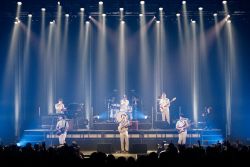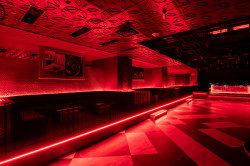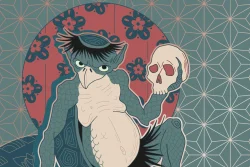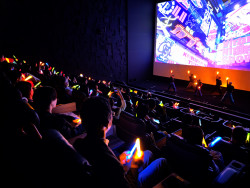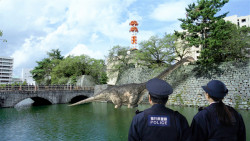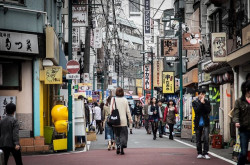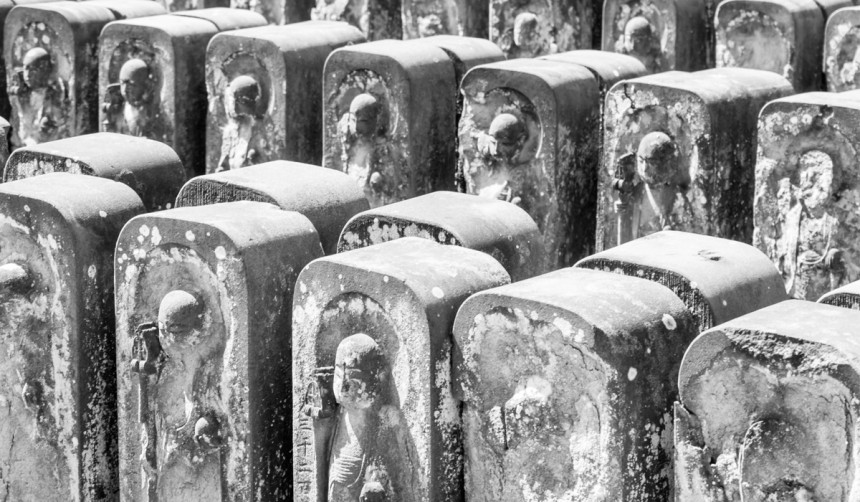
Just up the hill from Nippori Station on Tokyo’s Yamanote Line runs a ridge marking an ancient border between “Edo”—Tokyo’s former name—and the countryside. Samurais retreated from the bustle of the palace and politics to this cluster of shrines and temples where artisans practiced their skills. While the gently rolling green fields and rivers to the West gave way to high-rises and flashing trains, the surrounding streets and lanes still retain their Edo charm.

Yanaka is part of Yanesen, taking its name from the three neighborhoods it encompasses: Yanaka, Nezu, and Sendagi. Spared by the devastating damage of the 1923 earthquake, and later World War II, visitors can still find the old shitamachi (“downtown”) feeling.
More than a 100 shrines and temples are scattered about Yanesen, with over 70 of them in Yanaka alone. Suwa Shrine, above Nishi-Nippori Station, is one of the oldest in the city and home to Nippori and Yanaka’s local deity. Its weathered brown boards, shaded by large, old trees, offer a sense of peace and serenity, although the heavy wooden gates of Kyouji Temple still sport bullet holes from a long-ago battle. Yofokuji Temple’s Nioman Gate is protected by two brightly painted guardian statues built in the early 1700s. The Nezu Shrine, one of the few painted shrines, is famed for its tsutsuji (“azaleas”) and a miniature version of Fushimi Inari Shrine’s tori gate walk.

Old wooden houses, once typical of Tokyo, dot the area. Two- and three-story wooden buildings have shops on the ground floor and homes above. Vibrant displays of seaweed salads on giant blue and white ceramic plates, senbei (“rice cracker”), and flowers can still be found. An array of potted plants invariably fill the sidewalks or clamber up the walls. These plants traditionally provided food and medicine, while also helping to shade and cool the interior for residents with no other place to garden.
A short shopping street down a flight of steps, Yanaka Ginza remains a place for local craftspeople: Suigetsu Buseki, whose elegant bamboo creations can be found at his shop, Midori-ya; and Mitsuyaki Tsuyuki, who fashions clay puppets at his workshop, Shikuchi. (Mitsuya also offers puppet shows for groups of three or more.) Interspersed among these specialty stores are cafés and restaurants, tofu and tea shops, and other business that serve the daily needs of locals. The savory korokke (“deep-fried croquettes”) along with the sweet fish-shaped taiyaki (a sweet bean-filled pancake) provide a delicious excuse to pause and refresh.
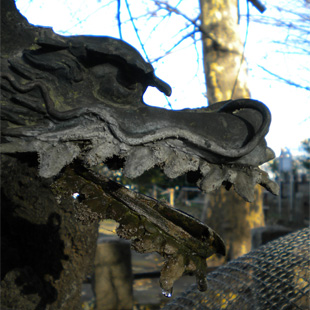
Yanaka Cemetery, one of Tokyo’s oldest, is the resting place for many artists, writers, and painters, as well as the Tokugawa family. It’s worth a stroll in any season for its magnificent trees and park-like atmosphere. The grand old sakura (“cherry blossom trees”) lining the paths are a flurry of blossoms in the spring, making this a popular viewing place. Moss-covered gravestones and winding paths where cats doze and families quietly tidy their ancestors’ graves are a welcome contrast to the busy shopping street. Tennoji Temple, founded in 1274, is home to a smaller version of the giant Buddha statues in Kamakura and Nara.
Last but not least, Yanaka is also a haven for art lovers and artists. Choso Museum, a sculpture gallery in the former home of Fumio Asakura, is dedicated to his work; while SCAI the Bathhouse is a contemporary art gallery housed in an old bathhouse. Traditional pigments ground from precious stones can be found at four stores in Yanaka. (Only nine still exist in Japan.) Isetatsu, one of Tokyo’s oldest and best traditional paper stores, offers a visually exquisite array of fans, dolls, and colorful chests of drawers.
